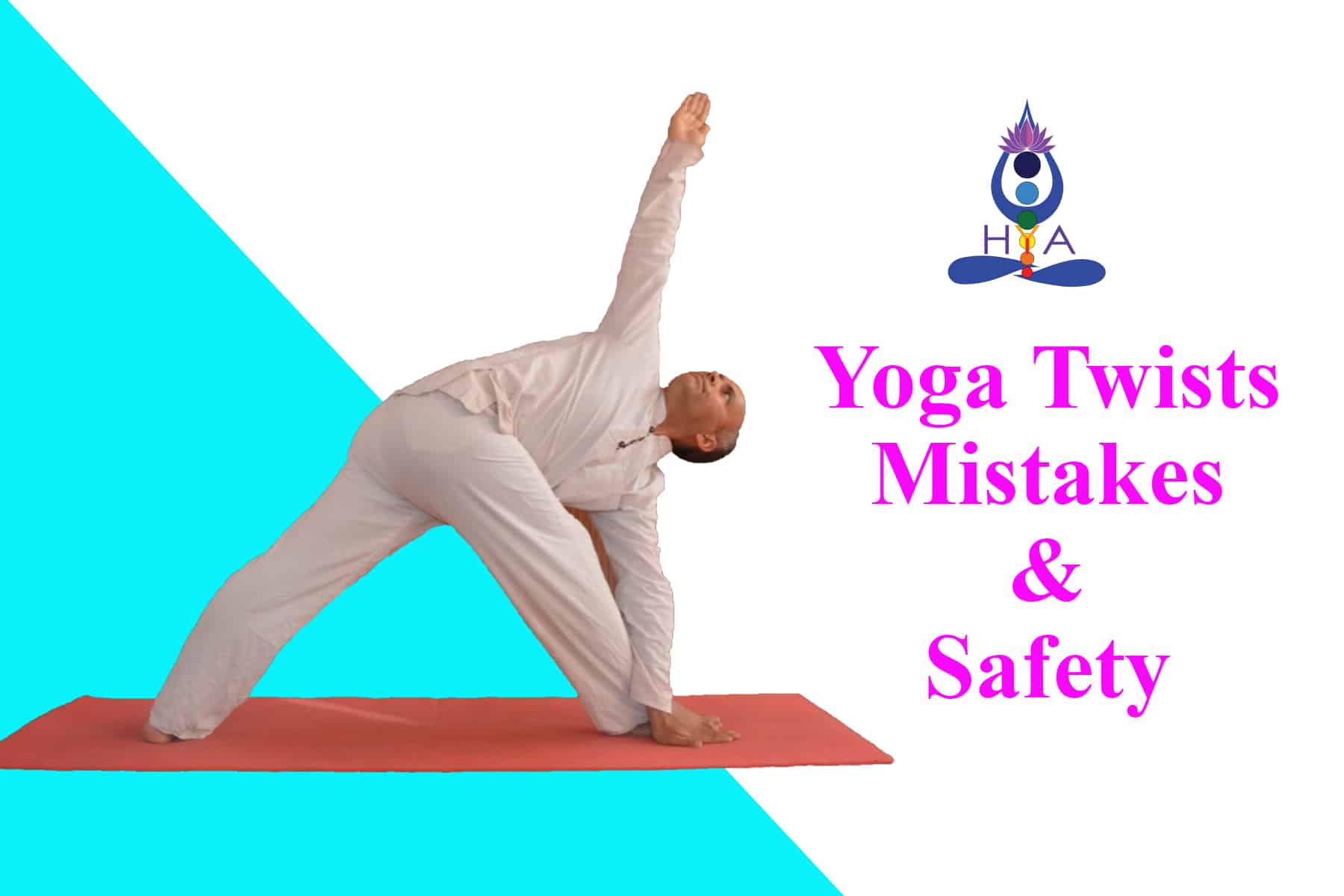
7 Jan 2023 HYN Himalayan Yoga Academy
In every yoga school around the world, during yoga sessions. There are generally two common mistakes in yoga twists:
- Practicing without a stable foundation.
- Twisting mostly from the lower back.
1. Unstable foundation:
In Every Yoga Twist, having a stable foundation is essential. If your foundation is unstable, the twisting action can be incorrect, increasing the risk of injuries.
If your pelvis is not squared, the following happens:
You twist from the lower (lumbar) spine (more on this in the next section). You only stretch superficial muscles (and not twisting the spine).
What is your foundation in twisting poses?
Your foundation is your pelvis in standing and seated twists such as Half Spinal Twist (Ardha Matsyendrasana). It is important for both your sitting bones to be on the ground to create a strong foundation. Avoid sitting on your heel or lifting one hip higher than the other. Keep your hips in line and your spine lengthened.
Modifications to improve yoga twists
As mentioned, grounding your sitting bones, pelvis, or shoulders (depending on the type of yoga twist) helps create a stable foundation. If you find this challenging, here are tips to modify the different yoga twists:
Reclining twists: In Supine Spinal Twist Pose (Jathara Parivartanasana), for example, rather focus on grounding both shoulders than touching your opposite knee to the ground. Modify your pose to ensure that your foundation is stable, then twist from there.
Sitting twists: In Half Spinal Twist (Ardha Matsyendrasana), you can place a block or cushion underneath your pelvis or straighten your lower leg. This will create a more stable foundation if you find it challenging to ground both sitting bones.
2. Twisting from your lower back
If you do not square your pelvis, you are twisting only from your lower, also called the lumbar spine. Why do we not want that?
Your lumbar spine vertebrae are designed in such a way that they can move forwards and backward, side to side, but barely rotate or twist. On the contrary, the thoracic spine (middle and upper spine) vertebrae glide against each other in rotation, ensuring easy twisting of the spine.
How to avoid twisting from your lower back
To avoid twisting only from your lower back, remember to keep your foundation stable and be aware of the range of mobility in the different parts of your spine. Start twisting only a few degrees in the lower spine and move up, twisting more in the middle and upper back.
Safety in Yoga Twists
Incorrect twisting of the spine can cause injuries and back pain. To practice yoga twists safely, keep the following tips in mind:
- Ground your shoulders or sitting bones (depending on the type of yoga twist).
- Lengthen your spine by reaching upwards with the crown of your head.
- When twisting, elongate your lower back and focus on twisting more in the upper and middle back.
- Remember to breathe! Your breath might feel slightly shorter as your rib cage contracts but continue breathing. As you inhale, lengthen through the spine. And as you exhale, twist a bit deeper.
Who should avoid Yoga Twists
In some cases, yoga twists can be dangerous. Knowing your limits and consulting with a healthcare professional before practicing certain poses is essential. If you are unsure if yoga twists are safe for you, please consult your doctor or physiotherapist first.
- Pregnancy
Yoga Twists shouldn’t be done during the time of pregnancy by female yoga practitioners as it might impact the baby in many ways.
- Digestive issues
Yes, yoga twists can help with digestion and metabolism. But if you struggle with chronic digestive issues, you should consult your doctor first. Extreme twisting places pressure on the intestines which can worsen gut-inflammatory symptoms.
- Spinal disc injury
Because you focus on your spine a lot in yoga twists, it can worsen spinal disc injuries. Consult your physiotherapist before attempting twisting poses.
- Joint Issues
The sacroiliac (SI) joint is located between your pelvis and lower spine. Incorrect or extreme twisting of the spine and pelvis can destabilize this joint and cause pain.
During your yoga teacher training in Nepal with Himalayan Yoga Academy, you will be thoroughly guided in various classifications of asanas. Twist Asanas will be taught by the gurus and will be briefly explained. These twist asanas should be learned properly from experienced yoga instructors. Here in our 200-hour Yoga Teacher Training and 300-hour Yoga Teacher Training, we request our yoga trainers to learn every asanas anatomy, and physiology with alignment. So they can teach properly to their students as they are yoga teachers after the course.
Reference: Special Thanks to Arhanta Yoga For such wonderful information that we can share it with the world through our wonderful blog platform.
